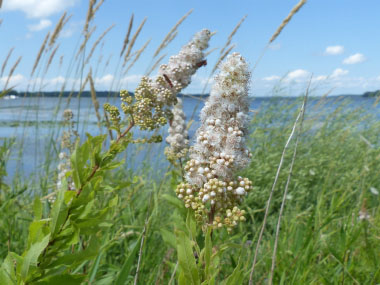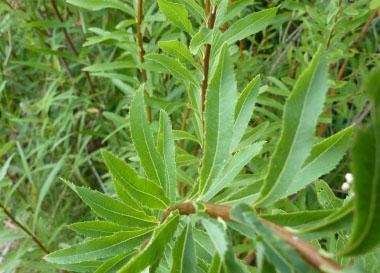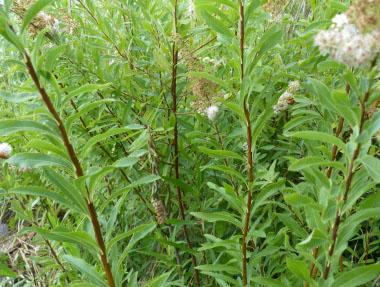





To support our efforts please browse our store (books with health benefits, etc.).
Meadowsweet is a perennial plant in the Rosaceae family. Although edible, meadowsweet is more recognized as an herbal medicine used to help with many maladies. In particular the flower head contains salicylic acid. The flowers produce nectar and pollen attracting various bees, wasps, adult long-horned beetles (Cerambycidae), and the moth Ctenucha virginica (Virginia Ctenucha).
Distinguishing Features
Meadowsweet is considered a shrub rather than a wildflower and it tends to grow in colonies. When in bloom it is very easy to identify. Meadowsweet is a large, clump-forming, upright perennial that typically grows relatively tall.
Flowers
Each flower is about 1/4" across, consisting of 5 white petals, 5 light green sepals, 5 light green pistils, and numerous stamens (20 or more). The petals are much longer than the sepals, while the filaments of the stamens are much longer than the styles of the pistils. Where the nectaries of each flower are located, there is a narrow ring-like structure that surrounds the 5 pistils in the center of the flower; this floral structure is pink, orange, or yellow. It flowers mid- to late summer.
 Fields
of Nutrition has medicinal benefits and vitamin/mineral content of Meadowsweet.
Fields
of Nutrition has medicinal benefits and vitamin/mineral content of Meadowsweet.
Leaves
Meadowsweet leaves are alternate (up to 3" long and 3/4" across) and occur along the young branches. The leaves are narrowly ovate, sharply serrated, pinnately veined, and glabrous (rarely sparsely hairy underneath); they have short petioles. The upper side of each leaf is medium green, while its lower side is pale green. The branches terminate in panicles of flowers.
Height
This plant can reach heights to anywhere between 1 to 2 metres (3 - 6 feet).
Habitat
Meadowsweet is typically found in swamps, marshes, fens, wet woods, or by lakes and rivers. It grows throughout North America, Europe, and in many areas of Asia.
Edible Parts
Young leaves are edible but are commonly used in soups and to make tea.
Other Name
White Meadowsweet.
Winter Survival Food Handbook

PDF Plant Magazines
Types of Wild Food
Geographic Zones Seasons
Disclaimer
EdibleWildFood.com is informational in nature. While we strive to be 100% accurate, it is solely up to the reader to ensure proper plant identification. Some wild plants are poisonous or can have serious adverse health effects.
We are not health professionals, medical doctors, nor are we nutritionists. It is up to the reader to verify nutritional information and health benefits with qualified professionals for all edible plants listed in this web site. Please click here for more information.
Why Edible Wild Food?
- Food costs are rising
- Free, wild food is readily abundant
- Wild food adds nutrition to your diet
- Wild food can help treat various medical conditions





